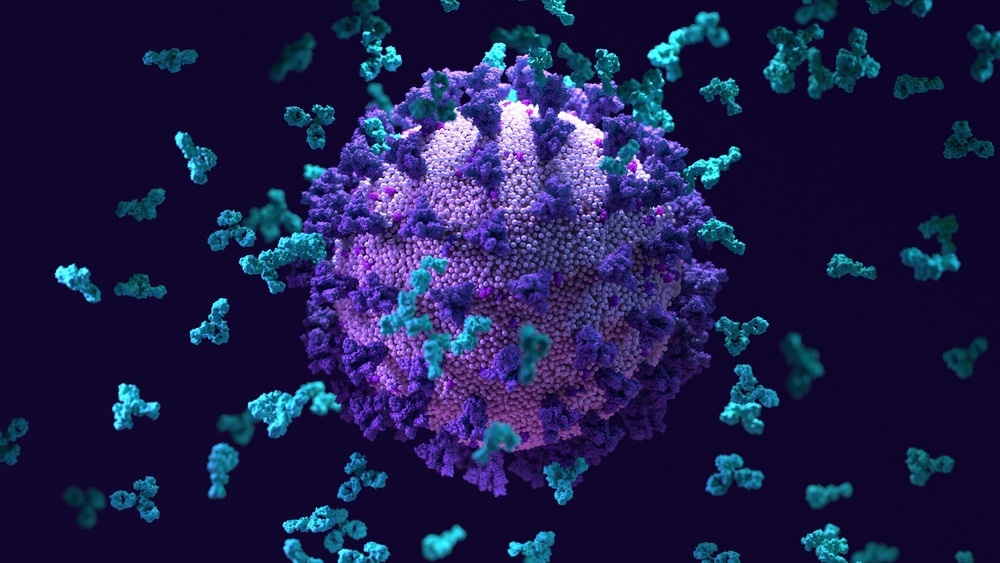The rapid global outbreak of a novel coronavirus, namely, severe acute respiratory syndrome coronavirus 2 (SARS-CoV-2), caused the coronavirus disease 2019 (COVID-19) pandemic, which has claimed more than 6.4 million lives worldwide. Scientists have worked relentlessly and developed vaccines, several of which have received emergency use authorization from global regulatory bodies, such as the U.S Food and Drug Administration (FDA). Subsequently, vaccination programs commenced in most regions of the world.
 Study: Ultrabright nanoparticle-labeled lateral flow immunoassay for detection of anti-SARS-CoV-2 neutralizing antibodies in human serum. Image Credit: Design_Cells/Shutterstock
Study: Ultrabright nanoparticle-labeled lateral flow immunoassay for detection of anti-SARS-CoV-2 neutralizing antibodies in human serum. Image Credit: Design_Cells/Shutterstock
Background
Post COVID-19 vaccination, evaluating the level of acquired immunity is extremely important. Typically, the effectiveness of a newly developed vaccine has been determined by measuring the levels of anti-SARS-CoV-2 immunoglobulin M (IgM) and immunoglobulin G (IgG) after vaccination. However, only estimating the concentration of these immunoglobulins does not correctly represent acquired immunity generated against SARS-CoV-2, as only a small portion of IgM and IgG can neutralize SARS-CoV-2.
During the course of the infection, the receptor-binding domain (RBD) in the spike protein of SARS-CoV-2 binds to the angiotensin-converting enzyme 2 (ACE2) receptor of the host. After COVID-19 vaccination, newly generated neutralizing antibodies (NAbs) bind to the RBD and neutralize SARS-CoV-2. Hence, the estimation of NAbs could provide more accurate information about the efficacy of the vaccine. Additionally, it could also be used to determine the effectiveness of new vaccination strategies in managing SARS-CoV-2 variants.
The high costs of conventional virus neutralization tests and the requirement for experts to perform them make it a less practical approach for mass detection of NAbs across the vaccinated population. To overcome the limitations of the conventional system, scientists have recently developed new techniques such as enzyme-linked immunosorbent assay, lateral flow immunoassay (LFIA), digital microfluidic systems, and surface plasmon resonance assay to detect SARS-CoV-2 NAbs.
Among the newly developed SARS-CoV-2 NAbs detecting methods, the LFIA has become the most popular point-of-care immunosensor due to its portability, low cost, and fast evaluation process. However, some limitations of this method include insufficient sensitivity and limited colorimetric range.
Although sandwich immunoassay exhibits higher specificity and sensitivity, it cannot accurately detect SARS-CoV-2 NAbs. This is because SARS-CoV-2 NAbs are composed of a complex range of antibodies for the neutralization process, and it is extremely difficult to find two different binding sites on NAb. In contrast, the direct competitive immunoassay is a reliable and cost-effective process which can be used for massive detection of SARS-CoV-2 NAbs.
A new study
Although organic luminogens with aggregation-induced emission (AIEgens) exhibits bright fluorescence at high concentration, their nanocrystal form cannot conjugate with antibodies and cannot be released from the pad. Hence, their utilization in ultrabright AIEgen nanocrystals in LIFA is restricted. A proper format for introducing ultrabright AIEgens into LIFA is required to overcome this restriction.
In a recent Biomaterials study, researchers developed AIEgen-embedded polystyrene (PS) nanoparticles-based LFIA that can accurately detect anti-SARS-CoV-2 NAb in serum samples of vaccinated individuals.
It was hypothesized that the rigidity of PS polymer containing steric phenyl rings and hydrophobic chains would significantly inhibit intramolecular motions and trigger ultrabright fluorescence of the embedded AIEgen in PS nanoparticles.
Study findings
Interestingly, the encapsulation of a green blue-emissive AIE490 into the carboxyl-modified PS nanoparticles (AIE490NP) enhanced the fluorescence signal by more than tenfold. The fluorescence intensity in AIE490-PS nanoparticle was much greater than in quantum dots nanoparticles, which have inherent fluorescing capacity.
The combination of AIE490-PS nanoparticle and LFIA provided a reliable detection method for anti-SARS-CoV-2 NAb in human serum. AIE490NP modified with ACE2 Fc chimera (ACE2-AIE490NP) acted as a fluorescence marker to sense anti-SARS-CoV-2 NAb. The nitrocellulose membrane coated with SARS-CoV-2 nucleocapsid S RBD fusion served as test lines.
The test line exhibited an ultrabright fluorescence signal upon encountering a negative serum sample, i.e., the samples did not contain anti-SARS-CoV-2 NAb due to strong ACE2-RBD binding. However, in the presence of a positive sample containing NAbs, the test line fluoresced mildly because of the high occurrence of NAb-RBD binding.
The AIE490-PS nanoparticle-based LFIA method for the detection of anti-SARS-CoV-2 NAb was validated using sixty-three COVID-19 vaccinated samples and seventy pre-SARS-CoV-2 serum samples. All the samples were positively identified by the newly developed method. AIE490-PS nanoparticle-based LFIA can also theoretically quantify NAbs in the test samples by using the available standard NAbs sample. The estimated detection time for one sample was 20 minutes.
Conclusions
Taken together, the utilization of AIEgen as the fluorescent marker has prominently improved the performance of LFIA. The primary advantages of this technique are the portability and cost-effectiveness of the LFIA strip, which are extremely important for their widespread application in detecting SARS-CoV-2 antibodies. AIE490-PS nanoparticle-based LFIA is an extremely useful device for determining the efficacy of COVID-19 vaccines and assessing the duration of immune protection after vaccination. To enhance the detection sensitivity, researchers are presently working on developing multicolor markers-based LFIA.